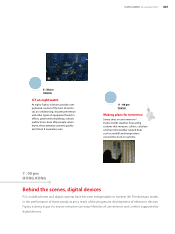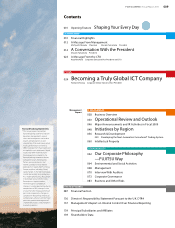Fujitsu 2010 Annual Report Download - page 18
Download and view the complete annual report
Please find page 18 of the 2010 Fujitsu annual report below. You can navigate through the pages in the report by either clicking on the pages listed below, or by using the keyword search tool below to find specific information within the annual report.
Aspirations as Fujitsu’s New President
Q.1
A.1
President Yamamoto, you have been with Fujitsu for 34 years. As president, how will you
bring your experience to bear on Fujitsu’s management?
Over my career, I have consistently been involved with businesses on the cutting edge of
innovation. I plan to make the most of my experiences to craft business models that are
based on advanced technology—business models for a new era.
I first joined Fujitsu in 1976. Over that 34-year span, I have personally witnessed a host of changes in technology.
When I first joined, Fujitsu was still largely a product-driven company. In fact, my involvement for many years
after coming aboard was mainly with product design and development. In 1979, I joined the team that developed
the OASYS word processor for the Japanese market, and was closely involved in the development of its successor,
the OASYS 100J. Although it was released back in 1980, I still vividly recall how gratifying it was to see customers at
their offices using a data terminal that I helped create.
The advent of computers brought significant strides to business productivity. Initially, though, computers were
prohibitively expensive, so it was common practice for office employees to take turns using one. Back then, people
had to enter all data into computers—you could even say that people had to serve the needs of the computer. It
was, I think, a very “computer centric” era in many ways. As use of PCs spread, both open source computing and
ICT*1 rapidly found their way into homes and offices. The emergence shortly thereafter of the Internet triggered an
evolution in network technology and sparked the coming of a “network centric” era which emphasized the role of
communications technology. Today, cloud computing*2 is poised to take its place as the latest social infrastructure.
During these eras of change, I have time and again been involved on the cutting edge of innovation where
revolutionary technologies have transformed society. Consequently, my career has given me many experiences and
insights that I can now call upon.
As cloud computing progresses, we are witnessing the start of a “human centric” era. Access to ICT will now be
available to everyone, without the need for complex knowledge or skills. As this era unfolds, Fujitsu stands ready to
provide customers with comprehensive services backed by superior technology, products, and solutions. As Fujitsu’s
president, I will take advantage of the experiences and insights I’ve gained over the years to build new business
models underpinned by cutting-edge technologies for this new era of business.
*2 Cloud Computing:
A system configuration
whereby tasks per-
formed by the user are
processed by Internet-
based servers rather
than a user’s own PC or
a server on a company’s
in-house network.
Toward an Era of Human Centric ICT
Scope of
ICT Usage
Internet
PC
Computer Centric
Network Centric
Human Centric
Practical Wisdom
• Cloud Computing
• Sensor Technology
• Ubiquitous Terminals
• Mobile Communications
1990 2000 2010 2020
Improving
Productivity
Transforming
Business Processes
Creating Knowledge,
Supporting Human Activities
Wealth of Services
Network
*1 ICT:
Information and Com-
munication Technology, a
term derived from IT
(Information Technology)
and communication,
which includes the
sharing of knowledge and
information via communi-
cation networks.
016 FUJITSU LIMITED Annual Report 2010
A Conversation With the President
























